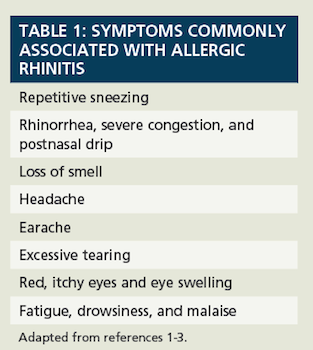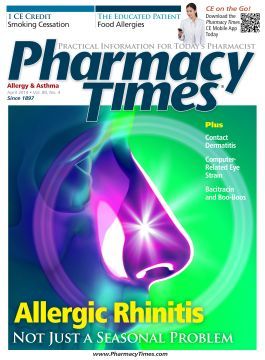Publication
Article
Pharmacy Times
Allergic Rhinitis: Not Just a Seasonal Problem
Author(s):
Allergic rhinitis can negatively impact one's quality of life by impairing concentration and causing fatigue and sleep disturbances.
Allergic rhinitis can negatively impact an individual’s quality of life by impairing concentration and causing fatigue and sleep disturbances.
Allergic rhinitis (AR), which can be classified as seasonal (hay fever) or perennial, can negatively impact an individual’s quality of life by impairing concentration and causing fatigue and sleep disturbances, depending on the severity and frequency of symptoms.1-3
Seasonal allergic rhinitis (SAR), which occurs in spring, summer, and early fall, is caused by allergic sensitivity to pollen (from trees, grasses, or weeds) or mold spores that are airborne.1,2 Perennial allergic rhinitis (PAR) typically causes year-round symptoms due to hypersensitivity to allergens such as dust mites, animal dander, cockroaches, and mold spores.1-4
Prior to initiation of pharmacologic therapy, a patient’s medical and medication history, possible allergens, and symptoms (including severity) should be thoroughly evaluated. The patient’s preferred treatment, its potential adverse effects, its cost, and its dosing frequency should be assessed. Normally, AR symptoms manifest in patients older than 2 years and are especially prevalent in patients 18 to 64 years of age (Table 1).1

AR is associated with many complications, including otitis media, sinusitis, recurring sore throat, cough, headache, disruption in sleep patterns, sleep apnea, depression, fatigue, anxiety, irritability, poor school or work performance, and impaired cognitive function.1-3 It is important to note that according to the American Academy of Allergy, Asthma & Immunology, an estimated 33% of individuals with rhinitis do not have allergies.5 These patients are classified as having non-AR, and the causes of symptoms include hormonal changes (eg, pregnancy, puberty, thyroid conditions), structural defects (eg, septal deviation, adenoid hypertrophy), and lesions (eg, nasal polyps and neoplasms).1-3,6
Pharmacists are in a pivotal position to counsel patients on pharmacologic agents (eg, beta-blockers, oral contraceptives, clonidine, angiotensin-converting enzyme inhibitors, acetylsalicylic acid and other nonsteroidal anti-inflammatory drugs, topical decongestants) that may increase the risk for rhinitis, and pharmacists can make recommendations to manage this effect.1-3,6
Nonprescription Treatments
Many treatment options are available to manage or reduce AR symptoms.1 The treatment of SAR and PAR is typically the same; however, individuals with PAR may be able to alleviate or decrease symptoms through environmental control (eg, elimination of dust mites, mold, or pet dander). While the ideal option for the management of AR is avoidance of allergy triggers, this is not always a practical approach; therefore, the use of 1 or more pharmacologic agents may be needed to reduce or prevent AR symptoms.
Treatment of AR may include a combination of environmental control measures and allergen avoidance, pharmacologic therapy, and immunotherapy.3,6 Patients may have to try several therapy options, including a combination of therapies, before finding an effective treatment. A host of nonprescription products are available for self-management of AR symptoms. These products include oral and ocular antihistamines; oral, nasal, and ocular decongestants; and mast cell stabilizers.1 To meet the needs of the adult and pediatric patient populations, single-entity and multiple-ingredient products are available in various dosage forms, including immediate- and sustained-release formulations, tablets, capsules, oral-disintegrating and chewable tablets, and flavored liquids.
Recently, several new products have become available, including Mucinex Allergy (Reckitt Benckiser), which contains the antihistamine fexofenadine in a once-a-day formulation. In addition, the nasal spray triamcinolone acetonide, which had been available only in prescription form, was cleared for FDA approval as Nasacort Allergy 24HR (Chattem), making it the first corticosteroid to be granted OTC approval.7,8 It is approved for patients 2 years and older to provide relief of nasal congestion, sneezing, rhinorrhea, and itchy nose.8 In March 2014, McNeil announced the new dissolving tablet formulation of Zyrtec, which can be taken without water.9
Antihistamines
Antihistamines are standard therapy for providing symptomatic relief of AR and are indicated for the relief of itching, sneezing, and rhinorrhea symptoms.1 First-generation antihistamines such as diphenhydramine are often associated with drowsiness/sedation, impaired mental alertness, and anticholinergic effects, so patients should be advised to use caution when taking these products.1
Second-generation nonprescription antihistamines (nonsedating antihistamines) available in nonprescription products include loratadine, cetirizine, and fexofenadine.1 Second-generation antihistamines are widely used and preferred because they typically do not cause significant drowsiness and are rapidly absorbed after oral administration, with peak plasma concentrations occurring after 1 to 3 hours.1
Decongestants
Because AR patients often experience nasal congestion, some patients elect to use nonprescription decongestants such as pseudoephedrine and phenylephrine in combination with antihistamines.1 These agents are indicated for temporary relief of nasal and eustachian tube congestion as well as cough associated with postnasal drip.1 Insomnia, nervousness, and tachycardia are examples of the most prevalent adverse effects of oral decongestants. They may also exacerbate medical conditions that are sensitive to adrenergic stimulation, such as hypertension, diabetes, coronary artery disease, prostatic hypertrophy, and elevated intraocular pressure.1
Because use of topical decongestants for more than 3 to 5 days could result in rhinitis medicamentosa (rebound congestion), patients should be advised to use these products for no longer than the recommended duration of time.1 Because some combination allergy medications include an antihistamine and a decongestant, patients should be advised to only use combination products when warranted, to avoid unnecessary drug use. Pharmacists are in a critical position to identify individuals who may be at risk for drug—drug interactions or may have contraindications to the use of antihistamines and decongestants.
Cromolyn Sodium
The nasal spray cromolyn sodium is approved for patients 5 years and older and is indicated for preventing and treating symptoms associated with AR.1 Intranasal cromolyn is not associated with any known drug interactions.1,10 Cromolyn sodium should be administered as 1 spray in each nostril 3 to 6 times daily, and treatment is more effective if initiated at least a week before seasonal symptoms occur.1 Symptomatic relief usually becomes apparent within 3 to 7 days, and therapy should be continued for at least 2 to 4 weeks to achieve optimal effect.1 The most common adverse effect is sneezing, and other adverse effects may include burning and stinging sensations in the nasal area.1,10
Ocular Allergies
If a patient is experiencing watery and itchy eyes due to allergies, ocular antihistamine products, such as pheniramine maleate and antazoline phosphate, are available in combination with the decongestant naphazoline.11 The most prevalent adverse effects associated with ophthalmic antihistamines include burning, stinging, and discomfort upon instillation.11
Ketotifen 0.025% is the only nonprescription antihistamine ophthalmic product on the market for the relief of ocular itching without the use of a decongestant.12,13 Ketotifen is classified as a noncompetitive histamine1-receptor antagonist and mast cell stabilizer that inhibits the release of mediators from cells involved in hypersensitivity reactions and is approved for use in patients 3 years and older for temporary relief of itchy eyes due to exposure to ragweed, pollen, grass, animal hair, and dander.12,13 The recommended dosage is 1 drop instilled into the affected eye(s) every 8 to 12 hours, but no more than twice daily.12,13 It is classified as pregnancy category C.11 Common adverse reactions include headache, dry eyes, and rhinitis.12,13 Ketotifen is not indicated for treatment of contact lens—related inflammation, and individuals who wear contacts should be instructed to wait at least 10 minutes before inserting their lenses after instillation of ketotifen.12,13
Patient Counseling
During counseling, patients should always be advised to adhere to the manufacturer’s directions and recommended dosages and be aware of potential adverse effects (Table 2). Patients not experiencing any relief after self-treatment should be advised to seek further medical evaluation from their primary health care provider to discuss other treatment options. In addition to providing drug information to patients, pharmacists can suggest various nonpharmacologic measures, such as using nasal saline solutions to relieve nasal irritation and dryness or using nonmedicated nasal strips to help relieve congestion.3,4
Table 2: Patient Counseling Tips
- Patient adherence is vital to controlling symptoms, so it is important to adhere to the recommended dosage of the selected product.
- Always consult your primary health care provider about treatment options if allergy symptoms return or worsen.
- To prevent or control symptoms, take allergy medications as soon as symptoms begin or before exposure to a known allergen.
- Prior to using any nonprescription product for allergic rhinitis, pregnant or lactating females, patients with preexisting medical conditions (eg, hypertension, diabetes, elevated intraocular pressure, chronic bronchitis, prostatic hypertrophy), or individuals taking other medications (eg, monoamine oxidase inhibitors, central nervous system depressants) should seek advice from their primary health care provider.
- Due to potential sedating effects, patients should avoid the use of alcohol when taking antihistamine products.
- For environmental control to decrease allergy symptoms, wash bedding in hot water every week, regularly vacuum carpets and upholstery, use allergy covers on pillows and mattresses, maintain a relative humidity level of 40% to 50% in the home to reduce mold, keep car and home windows closed (especially when pollen and mold levels are elevated), and routinely check pollen and mold counts in the local area.
- When possible, plan outdoor activities at times of the day that are not during peak pollen production, which occurs between 5:00 am and 10:00 am.
Adapted from references 1 and 14-16.
Ms. Terrie is a clinical pharmacy writer based in Haymarket, Virginia.
References:
- Scolaro K. Disorders related to colds and allergy. In: Krinsky D, Berardi R, Ferreri S, et al, eds. Handbook of Nonprescription Drugs. 17th ed. Washington, DC: American Pharmacists Association; 2012.
- Allergic rhinitis (hay fever). American Academy of Allergy, Asthma & Immunology website. www.acaai.org/public/advice/rhin.htm. Accessed March 3, 2014.
- Lambert M. Practice parameters for managing allergic rhinitis. Am Fam Physician. 2009;80(1).
- Allergic rhinitis. Medline Plus website. www.nlm.nih.gov/medlineplus/ency/article/000813.htm. Accessed March 3, 2014.
- Rhinitis. American Academy of Allergy, Asthma & Immunology website. www.aaaai.org/conditions-and-treatments/allergies/rhinitis.aspx. Accessed March 3, 2014.
- Sheikh J, Najib U. Rhinitis, allergic. eMedicine website. http://emedicine.medscape.com/article/134825-overview. Accessed March 3, 2014.
- Nasacort allergy spray going OTC. Medpage Today website. www.medpagetoday.com/AllergyImmunology/Allergy/42235. Accessed March 3, 2014.
- Nasacort Allergy 24HR. Chattem website. http://nasacort.com. Accessed March 5, 2014.
- McNeil adds Zyrtec Dissolve Tabs to best-selling allergy brand. Drug Store News website. http://drugstorenews.com/article/mcneil-adds-zyrtec-dissolve-tabs-best-selling-allergy-medicine. Accessed March 6, 2014.
- NasalCrom. Prestige Brands website. http://nasalcrom.com. Accessed March 1, 2014.
- Fiscella R, Jensen M. Ophthalmic disorders. In: Krinsky D, Berardi R, Ferreri S, et al, eds. Handbook of Nonprescription Drugs. 17th ed. Washington, DC: American Pharmacists Association; 2012.
- Zaditor. Novartis website. www.zaditor.com/info/answers/drug-facts.shtml. Accessed March 2, 2014.
- Alaway. Bausch & Lomb website. http://alaway.com/index.html. Accessed March 1, 2014.
- Claritin. MSD Consumer Care website. www.claritin.com/claritin/en/manage/tips.jspa. Accessed March 1, 2014.
- Alavert. Pfizer website. www.alavert.com/allergy_info.asp. Accessed March 1, 2014.
- Allergic rhinitis. United States National Library of Medicine website. www.ncbi.nlm.nih.gov/pubmedhealth/PMH0001816/. Accessed March 1, 2014.







